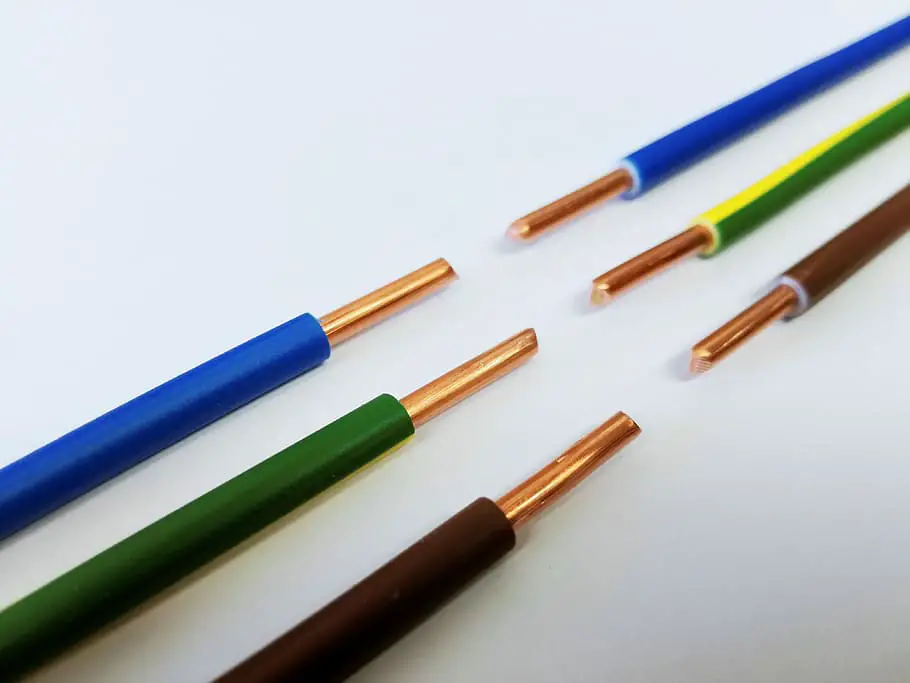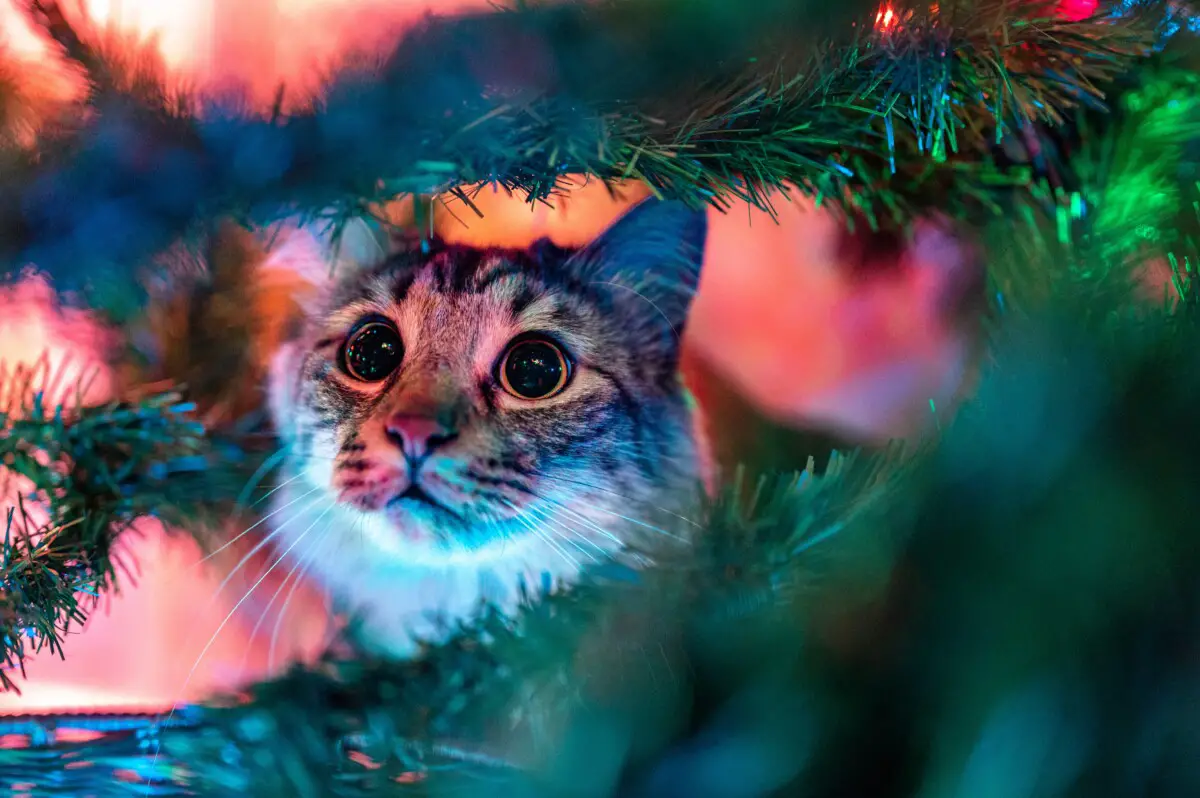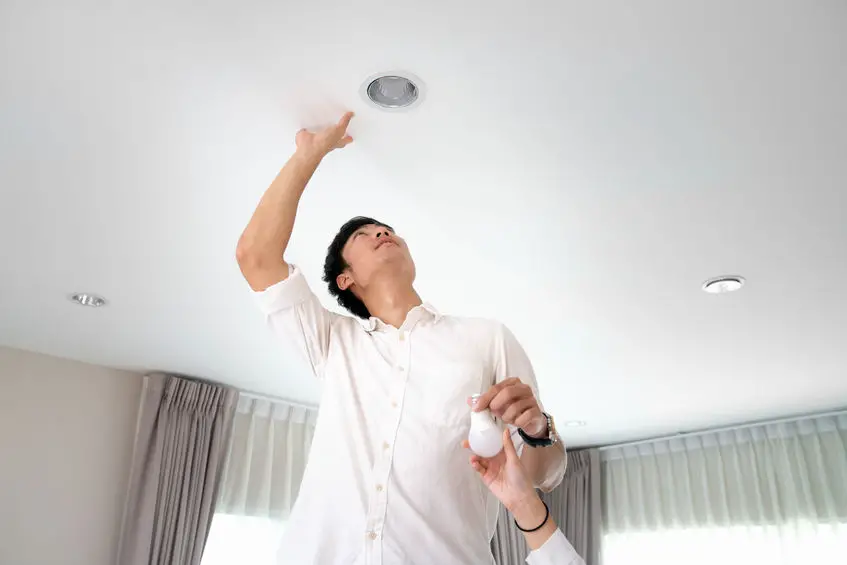Materials That Christmas Lights Can And Can’t Safely Touch
When you are in the process of hanging up your Christmas lighting for the holidays you may be concerned about what is and what isn’t okay for these lights to touch since it’s possibly dangerous to hang in certain materials.
LED Christmas lighting is safe to touch all common materials since they don’t get nearly hot enough to cause a fire. However, you should avoid letting incandescent Christmas lighting touch materials that are normally flammable such as fabrics and paper since incandescent lights can get quite hot.
While this is the short-form answer there is still plenty to discuss regarding which materials should or shouldn’t be touched by Christmas lighting, which we will go on to do in this article.
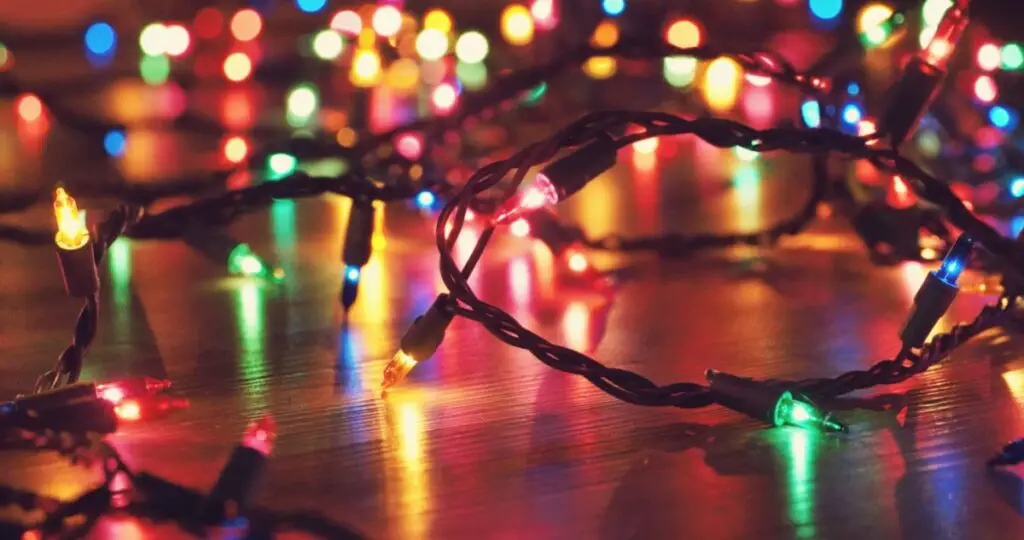
Contents
Temperature Difference Between LED And Incandescent Christmas Lights
We have established that LED Christmas lights are suitable for most applications whereas you should take some more caution with incandescent lights. But what’s the reason for this?
The reason why you should be more careful with the placement of your incandescent Christmas lights is that they get way hotter than LED Christmas lights do.
The LED technology as a whole has a temperature range between 20-80 °C (68-140°F) at its hottest point whereas incandescent lights normally operate at 2500 °C (4600 °F) in the light-producing tungsten filament. Read more about the temperature of light bulbs in my article Comparing Light Bulby By Heat.
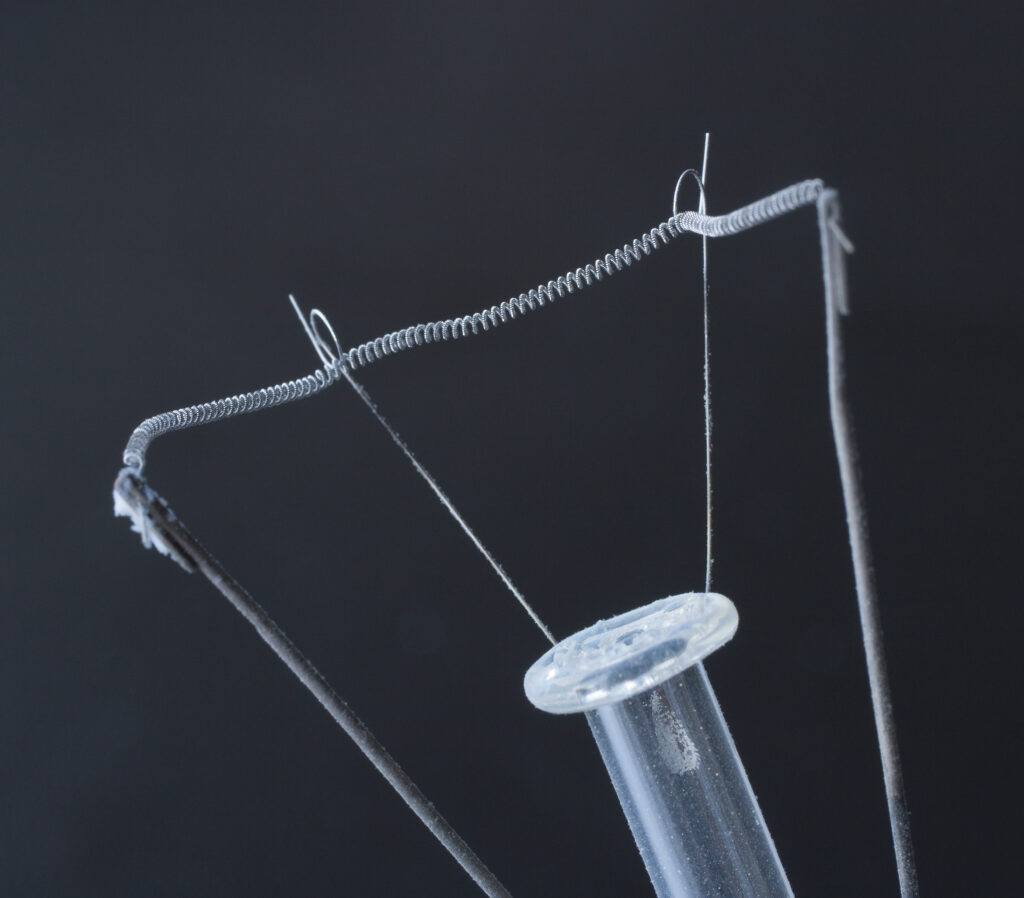
However, these values assume that we are talking about applications that are normally bigger than Christmas lighting, such as regular-sized light bulbs. This means that it’s safe to assume that small LED diodes operate on the lower end of that scale and that incandescent lights don’t reach temperatures that high.
Since these different lights produce such vastly different temperatures it makes sense that one can touch most materials and that the other should be placed with more caution.
That said, there are certain scenarios where LED lights might overheat and subsequently break or cause a fire. Click here to read my article Can LEDs Overheat and Become A Fire Risk?
Christmas Lighting Against Different Materials
Since we have concluded that certain materials are more sensitive to the heat from lighting than others we are now going to go into each material in depth and see what is okay for Christmas lights to touch or not.
Can Christmas Lights Touch Fabrics?
The first major material on this list is fabrics. Some common instances of fabric within a home would include:
- Curtains
- Blankets
- Tablecloths
- Carpets
- Bedding (sheets, comforters, duvet covers)
While fabric can be quite durable it is also more on the flammable side. For example, cotton tends to catch fire and burn at around 410 degrees Fahrenheit (210 Celsius). This means that if your incandescent Christmas lights were to make contact with your cotton bedsheets for an extended period of time there is a possibility they could catch fire.
Even though this is a possibility the probability of it is pretty low. Unless you completely trap an incandescent light in the fabric there is usually enough air circulation around it to dissipate the heat generated by the light.
Assuming that you’re using incandescent lights and you’re using them in a standard and sensible matter you are mostly fine having them touch a bit of fabric. However, you do want to avoid covering them up with fabrics, but a little touching should have little to no effect.
If you want to be completely risk-free you can simply use LED lighting instead. Since LEDs barely get hot to the touch they will not pose a risk to your curtains or blankets. I’ve personally had LED Christmas string lights hung in curtains and it works great!
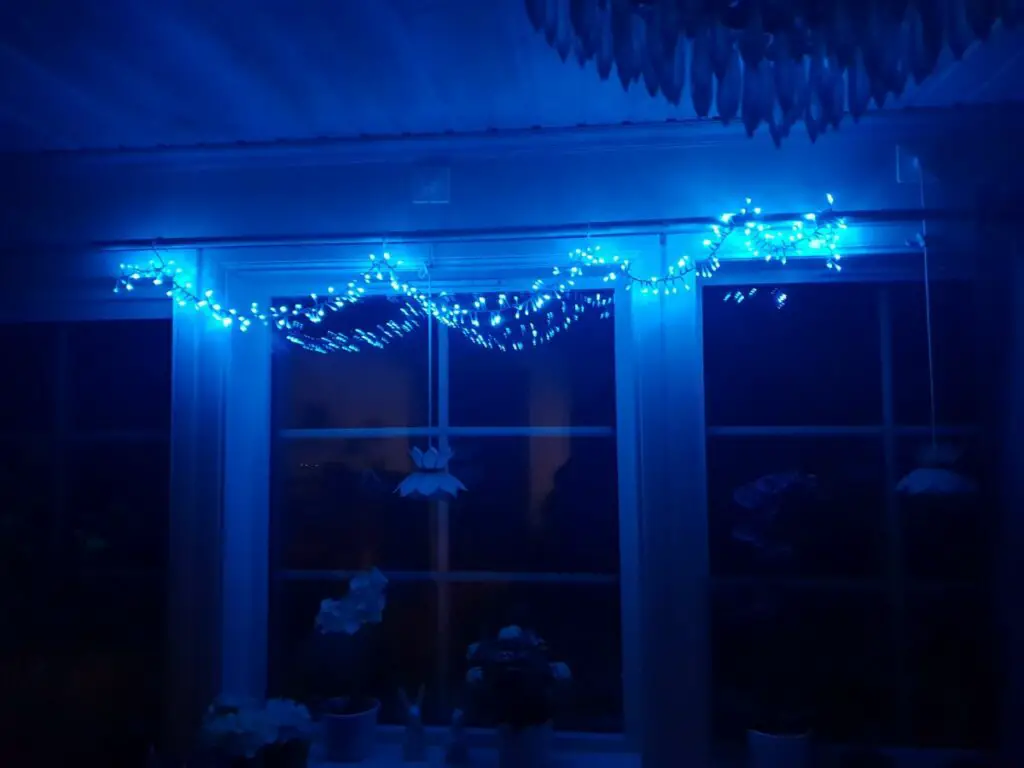
Can Christmas Lights Touch Plastic?
Plastic is another material that commonly occurs in a home. Some common applications of plastic that may normally come in contact with your Christmas fairy lights would be some of the various holiday decorations you want to have in conjunction with your lights.
Plastic is generally pretty durable. The main danger of having Christmas lights touching plastic is the risk of the plastic melting, but plastic doesn’t normally melt that easily.
The melting temperature of plastic depends on its chemical composition but generally speaking it needs to reach at least 200°C (392°F) before it melts. However, a lot of plastics only need to reach a temperature of around 40°C (104°F) to be moldable. Read more about plastics and their melting points in this article.
With this laid out, it would be wise to not let your incandescent lights touch plastic since there is a chance it could become moldable or even melt when in contact for too long. Some or little contact between these lights and plastic may be fine but it’s not recommended.
However, LED lights are perfectly fine with touching plastics. As explained, LEDs don’t get nearly as hot as incandescent lights and therefore pose a much smaller risk of fire than incandescent lights do. To further this point, most casing and protection made for LEDs are made out of plastic, meaning that the LED technology is well suited to touch plastics.
Can Christmas Lights Touch Wood?
While a lot of other materials on this list are more common than wood it’s also something that occurs a fair amount in the home. A few examples of this may be:
- Chairs
- Tables
- Desks
- Beds
- Flooring
- Wooden decor items (e.g candle holders and vases)
Wood itself is a flammable material. That said, wood normally doesn’t ignite until it hits temperatures around 300°C (572°F), which is normally hotter than the heat fairy lights transfer to surrounding items.
That said, it is possible for incandescent light bulbs to leave blackened burn marks on wood it comes in contact with, meaning that incandescent Christmas lights can do the same since they operate on the same hardware.
For this reason, it may be wise to opt for LED Christmas lighting since it won’t reach temperatures that high, to begin with. Even though small incandescent lights probably won’t damage any wood it absolutely has the ability to and should be treated with that level of respect.
Can Christmas Lights Touch Glass?
Another common material that can come in contact with your Christmas lights is glass. Glass can come in a whole lot of forms, ranging from the glasses we drink out of to glass ornaments or windows.
Normally glass is a pretty delicate material that you have to handle with a lot of care, but when it comes to its relation with heat it tolerates it very well.
Putting Christmas lights against glass is mostly pretty safe. Glass has an extremely high melting point of around 1500°C (2,700°F) and can handle a lot of thermal stress. Since Christmas lights don’t emit temperatures hot enough to cause damage to glass they are safe to put against it.
This is also why glass as well as quartz is often used as the bulb part on incandescent light bulbs because its ability to withstand high temperatures is great.
Can Christmas Lights Touch Walls?
While walls aren’t necessarily a material itself it’s common to wonder whether or not Christmas lighting can be in direct contact with your walls or not.
In general, having Christmas lights touching your walls is safe assuming that the lights are in good condition. Christmas lights have a tendency to degrade in condition pretty fast due to how a lot of it isn’t always stored in the best conditions once the holidays are over.
The regular heat generated by these lights is generally not a problem when it comes to having direct contact with walls unless we are talking about larger incandescent bulbs, which we normally aren’t.
For that reason, it’s more important to make sure the quality and condition of the lights are good. For this, I’d recommend checking them for any signs of damage, such as frayed wires or broken bulbs.
If you find that there is nothing wrong with your lights they should be good to make contact with your walls, however, it’s generally recommended that you don’t obstruct the lights more than necessary so that the heat can dissipate evenly.
Can Christmas Lights Touch Metals?
While this isn’t super common there could be plenty of scenarios where you find yourself in a situation where your Christmas lighting makes contact with metals.
Having your Christmas lights in contact with metals is usually not a big problem since these lights could practically never make the metal reach its melting point.
That said, there are other things to consider when installing lighting around metals. One thing to consider is the condition of the lights. If the wiring ends up being damaged and makes contact with the metal it could cause the lights to short circuit, which would cause the breaker to trip or the lights to break.
In general, you should be safe to have your lights touching metals as long as it doesn’t make direct contact with the wiring within.
Can Christmas Lights Touch Paper?
Another less common material found within homes is paper. Despite being less common than some of the other materials on this list there are still plenty of instances of it in any given household. Some examples of paper in the house include items such as:
- Writing paper and envelopes
- Wrapping paper
- Gift bags
- Paper bags
- Books and magazines
- Posters and artwork
- Paper towels
Paper itself is a flammable material, meaning that it’s wise to avoid it making direct contact with incandescent lights for longer periods of time since it can cause a fire if it gets too hot. However, with LED lights you run virtually no risk of fire since they operate at much cooler temperatures.
Having lights in close proximity to paper items is okay since the heat transfer through air won’t cause it to overheat enough to the point of fire, but you should be a bit cautious having them in direct contact with each other.
Can Christmas Lights Touch Plants?
When hanging up your Christmas lighting it may be tempting to hang them on your plants since you already hang them on your Christmas trees. But is this something you should avoid doing or is it fine to do so?
Generally speaking, having lights on a plant is safe. That said, there are some things you should consider when putting lights on a plant.
One thing to consider is the weight of the lights. If you place a heavy light on a thin part of a plant it won’t be able to support the weight of the light and therefore damage the plant. To avoid this you should be using string lights and place them smartly so that the weight is evenly distributed.
Another thing to keep in mind when you’re dealing with incandescent lights is to not put them too close to the plant. The heat generated by the lights can damage the plant when they are in direct contact for longer periods of time.
To avoid this you should either use LED lights or lights that are specifically marked as being safe to use on trees or other plants. This way, you run virtually zero risk of heat damage.
Can Christmas Lights Touch Water?
When it comes to Christmas lights touching water or any other liquid it’s no longer a question of overheating and it’s instead a matter of how waterproof the lights are.
In general, you shouldn’t have your lights in direct contact with any sort of moisture. This is because of short circuits, which is what happens when electricity finds its way through the water instead of the wires as intended.
That said, if you have lighting which is safe and approved for outdoor use it may be okay for it to be in contact with some moisture. Click here for a better resource explaining safety ratings against water.
Increasing The Safety Of Your Christmas Lights
We have now covered the relationship between Christmas lights and common materials found within the home. While it’s generally safe to have Christmas lights in contact with most items on the list there are still some that should be avoided, like fabrics and paper. But how can we change this if we really want to put lights near these flammable items?
There are a few ways we can increase our safety regarding this. The easiest solution is to simply get rid of all old incandescent lights and only use LED lighting as your decor.
Since LEDs don’t get very hot at all they are a perfect lighting solution to put close to or in direct contact with more sensitive materials since the chance is very small that it will cause any danger.
Another precaution you can take is to give the lights some breathing room. All forms of lighting build up heat as a byproduct of the light it creates, which has to dissipate into the surrounding air in order for the light to work properly.
In order to allow the light to dissipate heat properly you should give it room and not cover it with thick materials that trap heat. If the heat gets trapped it could lead to the light breaking or even catching on fire, so try to avoid suffocating the lights.
A final tip for increasing your safety is to simply make sure that the lights are in good condition.
The reason why checking on the condition of your lights is important is that many people don’t store them in the most ideal space during the offseason.
A common example of this is storage areas where rats have access. Rats are notorious for chewing through stored fabrics and wires given the opportunity, so it’s wise to monitor the condition of the light the next year it gets brought back and put up.
Summary
LED Christmas lights are safe to touch practically all materials as they do not get hot enough to cause a fire. Incandescent lights, on the other hand, get much hotter than LEDs and should be placed with more caution.
For example, incandescent lights should not touch flammable materials such as fabrics and paper. LED lights are safe to touch plastic and wood, but incandescent lights can cause them to melt or burn. It is generally safer to use LED lights instead of incandescent lights because of this.

